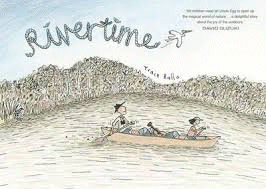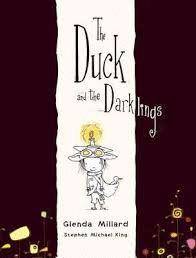Rivertime
Trace Balla
Allen & Unwin, 2014
hbk., 80pp., RRP $A24.99
9781743316337
Clancy is 10.5 years old or 3832.5 days or 91 980 hours old, and is obsessed with numbers. He lives with his mum who is an artist and his uncle Egg, a very keen bird-watcher. Egg has been waiting for Clancy to grow as high as his chest so they can go on a paddling trip up the river together. Clancy isn’t so sure that it will be much fun, especially when he discovers that it is an extended camping trip – ten days, 240 hours, 14 400 minutes – and in a canoe, not a hovercraft, and only essentials are allowed. He writes, “Day 1: After a lumpy, bumpy night, I’m grumpy…” and watches Egg load the canoe grumbling and mumbling and knowing he is not going to like this adventure and an encounter with a brown snake in the water just as they’re contemplating a swim doesn’t change his view. But as the journey goes on, Clancy sees and experiences new things – things that are more interesting than his television and other toys left behind – and learns much about life in all its colours, shades and hues, including rivertime, the tidal gap between breathing in and breathing out and which offers such peace and tranquillity and reflection.
Set on the Glenelg (Bochara) River which flows out of Gariwerd (aka The Grampians), parts of which are the traditional home of the Gundjitmara and Boandik peoples, and told in a graphic novel format, this is a story of Clancy’s journey – not just along the river but also the physical, mental and emotional journey of the transition from child to young man. His final triumph of conquering the jetty exit is perfect! And his victory dance shows just how far he has travelled. Its gentle colours add to the atmosphere and each page is peppered with little bush creatures and their names, the things that the Clancy of the beginning wouldn’t see and couldn’t appreciate, but which the Clancy of the end values, even abandoning his obsession with numbers. Now, when a speedboat cuts through the water, Clancy feels sorry for the river’s creatures. As David Suzuki says, “All children need an Uncle Egg to open up the magical world of nature.”
This is an extraordinary book – one to be read alone and savoured because there are so many layers and levels to it. It’s not just the story of Clancy and Egg and their journey, but a calming, almost meditative, read for the reader. Often when we pick up a picture book we just skim read it just as we can “skim read” our daily lives because we don’t think we have time to delve deeper and really appreciate and value what we have, but as you get into this story it drags you in, just as it did Clancy, until you become absorbed and oblivious to the distractions around you. Just as the wallaby swimming across the river and the koala changing trees, it beckons you to try a new place just because you can. The handwritten font enhances the concept of it being a personal journey for both writer and reader. So while the younger student may read it as Clancy having an adventure with his Uncle Egg, there is much more that the older reader will gain from it too. In the penultimate frame, Egg says, “You’ve come a long way, kid”, to which Clancy replies, “Yeah, and I could keep going.” Sums it all up perfectly, in my opinion.

